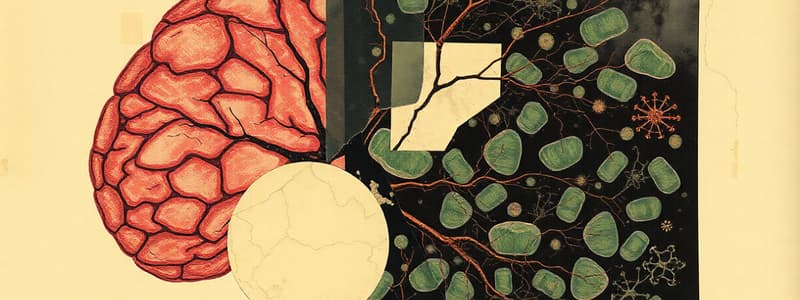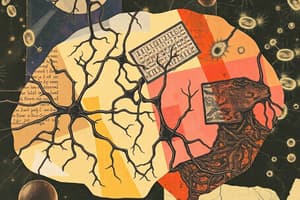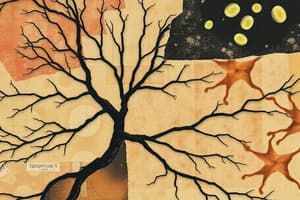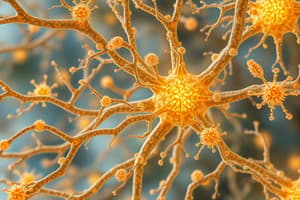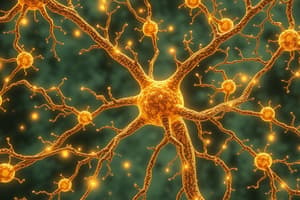Podcast
Questions and Answers
What is one of the primary functions of cerebrospinal fluid (CSF)?
What is one of the primary functions of cerebrospinal fluid (CSF)?
- Transmits signals between spinal nerves
- Increases brain weight for stability
- Cushions the brain from trauma (correct)
- Provides electrical stimulation to neurons
Which statement accurately describes spinal nerves?
Which statement accurately describes spinal nerves?
- There are 50 pairs of spinal nerves in total
- They only transmit sensory information
- They are mixed nerves carrying both sensory and motor fibers (correct)
- Spinal nerves are involved solely in autonomic functions
The sympathetic nervous system is primarily responsible for which of the following?
The sympathetic nervous system is primarily responsible for which of the following?
- Regulating hormonal balance in the body
- Activating the 'fight or flight' response (correct)
- Promoting digestion and energy conservation
- Facilitating 'rest and digest' responses
What type of function do cranial nerves primarily serve?
What type of function do cranial nerves primarily serve?
Which part of the nervous system is responsible for reflex actions?
Which part of the nervous system is responsible for reflex actions?
Which category do the vagus nerve and the sympathetic nerves belong to?
Which category do the vagus nerve and the sympathetic nerves belong to?
How many pairs of spinal nerves are categorized as lumbar?
How many pairs of spinal nerves are categorized as lumbar?
What function do autonomic nerves perform?
What function do autonomic nerves perform?
What role do peripheral nerves play in the nervous system?
What role do peripheral nerves play in the nervous system?
Which statement about the peripheral nervous system is true?
Which statement about the peripheral nervous system is true?
What is the primary function of neurones?
What is the primary function of neurones?
Which cells are responsible for myelinating axons in the peripheral nervous system (PNS)?
Which cells are responsible for myelinating axons in the peripheral nervous system (PNS)?
What role do astrocytes play in the central nervous system (CNS)?
What role do astrocytes play in the central nervous system (CNS)?
What is the function of the myelin sheath?
What is the function of the myelin sheath?
How do neurotransmitters transmit signals across a synapse?
How do neurotransmitters transmit signals across a synapse?
What initiates the release of neurotransmitters from synaptic end bulbs?
What initiates the release of neurotransmitters from synaptic end bulbs?
What is the significance of the blood-brain barrier?
What is the significance of the blood-brain barrier?
What role does the myelin sheath play in nerve impulse conduction?
What role does the myelin sheath play in nerve impulse conduction?
Which of the following is true about dendrites?
Which of the following is true about dendrites?
What distinguishes afferent impulses from efferent impulses?
What distinguishes afferent impulses from efferent impulses?
How do local anesthetics work to manage pain?
How do local anesthetics work to manage pain?
What does irritability refer to in the context of neurones?
What does irritability refer to in the context of neurones?
What is the function of neurotransmitters?
What is the function of neurotransmitters?
What is a characteristic feature of neuroglial cells?
What is a characteristic feature of neuroglial cells?
What happens during the depolarization phase of an action potential?
What happens during the depolarization phase of an action potential?
Which of the following is primarily responsible for the transmission of signals at synapses?
Which of the following is primarily responsible for the transmission of signals at synapses?
What division of the nervous system includes the brain and spinal cord?
What division of the nervous system includes the brain and spinal cord?
Which neurotransmitter is primarily involved in muscle contraction?
Which neurotransmitter is primarily involved in muscle contraction?
What is the primary role of the hypothalamus in the nervous system?
What is the primary role of the hypothalamus in the nervous system?
Where does signal transmission occur in the neuron?
Where does signal transmission occur in the neuron?
Which brain area is responsible for higher cognitive functions?
Which brain area is responsible for higher cognitive functions?
What is the function of the thalamus?
What is the function of the thalamus?
The hypothalamus controls ______ and hormone regulation.
The hypothalamus controls ______ and hormone regulation.
What is the primary function of the midbrain?
What is the primary function of the midbrain?
The pons is responsible for controlling cardiovascular functions.
The pons is responsible for controlling cardiovascular functions.
Which of the following brain areas controls reflex actions such as coughing?
Which of the following brain areas controls reflex actions such as coughing?
Which system works alongside the nervous system to control body functions?
Which system works alongside the nervous system to control body functions?
What are the two main divisions of the nervous system?
What are the two main divisions of the nervous system?
Which of the following cells is a key component of nervous tissue?
Which of the following cells is a key component of nervous tissue?
What is the primary function of the axon?
What is the primary function of the axon?
Which cells form the myelin sheath around axons in the peripheral nervous system?
Which cells form the myelin sheath around axons in the peripheral nervous system?
What are the gaps in the myelin sheath along the axon called?
What are the gaps in the myelin sheath along the axon called?
What is the main function of dendrites?
What is the main function of dendrites?
What property of neurones refers to their ability to respond to stimuli?
What property of neurones refers to their ability to respond to stimuli?
What is the function of neuroglial cells?
What is the function of neuroglial cells?
Which type of neuroglial cell becomes phagocytic in areas of inflammation?
Which type of neuroglial cell becomes phagocytic in areas of inflammation?
Which neuroglial cells form the main supporting tissue of the central nervous system?
Which neuroglial cells form the main supporting tissue of the central nervous system?
Which of the following protects the brain from toxic substances in the blood?
Which of the following protects the brain from toxic substances in the blood?
What is stored in synaptic vesicles?
What is stored in synaptic vesicles?
Where are neurotransmitters released to transmit a nerve impulse?
Where are neurotransmitters released to transmit a nerve impulse?
What process releases neurotransmitters from synaptic vesicles?
What process releases neurotransmitters from synaptic vesicles?
What is the effect of local anesthetics on nerve transmission?
What is the effect of local anesthetics on nerve transmission?
Which part of the brain is the largest?
Which part of the brain is the largest?
What is the main function associated with the cerebrum?
What is the main function associated with the cerebrum?
What is the main function of the hypothalamus?
What is the main function of the hypothalamus?
What role does the midbrain play in the nervous system?
What role does the midbrain play in the nervous system?
Which structure forms a bridge between the two hemispheres of the cerebrum?
Which structure forms a bridge between the two hemispheres of the cerebrum?
What is the medulla oblongata continuous with?
What is the medulla oblongata continuous with?
What is one of the primary functions of cerebrospinal fluid?
What is one of the primary functions of cerebrospinal fluid?
Which division of the autonomic nervous system activates the 'fight or flight' response?
Which division of the autonomic nervous system activates the 'fight or flight' response?
Flashcards
Nervous Tissue
Nervous Tissue
Composed of neurons (nerve cells) and glial cells (support cells).
Cell Body (Soma)
Cell Body (Soma)
The central region of the neuron containing the nucleus and organelles.
Axon
Axon
Conducts electrical impulses away from the cell body.
Schwann Cells
Schwann Cells
Signup and view all the flashcards
Nodes of Ranvier
Nodes of Ranvier
Signup and view all the flashcards
Dendrites
Dendrites
Signup and view all the flashcards
Irritability
Irritability
Signup and view all the flashcards
Conductivity
Conductivity
Signup and view all the flashcards
Microglia
Microglia
Signup and view all the flashcards
Astrocytes
Astrocytes
Signup and view all the flashcards
Oligodendrocytes
Oligodendrocytes
Signup and view all the flashcards
Blood-Brain Barrier
Blood-Brain Barrier
Signup and view all the flashcards
Synapse
Synapse
Signup and view all the flashcards
Neurotransmitters
Neurotransmitters
Signup and view all the flashcards
Myelin Sheath
Myelin Sheath
Signup and view all the flashcards
Action Potentials
Action Potentials
Signup and view all the flashcards
Afferent Impulses
Afferent Impulses
Signup and view all the flashcards
Efferent Impulses
Efferent Impulses
Signup and view all the flashcards
Depolarization
Depolarization
Signup and view all the flashcards
Local Anesthetics
Local Anesthetics
Signup and view all the flashcards
Neuralgia
Neuralgia
Signup and view all the flashcards
Central Nervous System (CNS)
Central Nervous System (CNS)
Signup and view all the flashcards
Peripheral Nervous System (PNS)
Peripheral Nervous System (PNS)
Signup and view all the flashcards
Cerebrum
Cerebrum
Signup and view all the flashcards
Thalamus
Thalamus
Signup and view all the flashcards
Hypothalamus
Hypothalamus
Signup and view all the flashcards
Midbrain
Midbrain
Signup and view all the flashcards
Pons
Pons
Signup and view all the flashcards
Medulla Oblongata
Medulla Oblongata
Signup and view all the flashcards
Cerebrospinal Fluid (CSF)
Cerebrospinal Fluid (CSF)
Signup and view all the flashcards
Nervous System
Nervous System
Signup and view all the flashcards
Axon Function
Axon Function
Signup and view all the flashcards
Schwann Cell Function
Schwann Cell Function
Signup and view all the flashcards
Thalamus Function
Thalamus Function
Signup and view all the flashcards
Hypothalamus Function
Hypothalamus Function
Signup and view all the flashcards
Pons Function
Pons Function
Signup and view all the flashcards
Cerebrospinal Fluid (CSF) Functions
Cerebrospinal Fluid (CSF) Functions
Signup and view all the flashcards
Sympathetic Nervous System
Sympathetic Nervous System
Signup and view all the flashcards
Parasympathetic Nervous System
Parasympathetic Nervous System
Signup and view all the flashcards
Synaptic End Bulbs
Synaptic End Bulbs
Signup and view all the flashcards
Synapse Function
Synapse Function
Signup and view all the flashcards
Study Notes
- The nervous system detects and responds to changes inside and outside the body.
- The nervous system, along with the endocrine system, controls body functions and maintains homeostasis.
- Nervous system stimulation provides an immediate response, while endocrine activity is slower and prolonged.
Divisions of the Nervous System
- Central Nervous System (CNS): brain and spinal cord.
- Peripheral Nervous System (PNS): all other nerves.
Nervous Tissue Cells
- Neurons
- Schwann Cells
- Neuroglial/Glial Cells
Neuronal Anatomy
- Axons are communication routes between the cell body and axon terminals.
- Axons conduct electrical impulses away from the neuron's cell body and can be longer than 1 meter.
- Large axons in the peripheral nervous system are surrounded by a myelin sheath (series of Schwann cells).
- The myelin sheath is high in phospholipid (fatty) content, offering electrical insulation.
- Nodes of Ranvier are exposed areas between Schwann cells that assist rapid transmission of action potentials in myelinated neurons.
- Dendrites are extensions of the cell body that provide a large surface area to receive information to pass to the cell body.
- Dendrites have a similar structure to axons but are shorter, and the plasma has dense chemical ion channels for impulse transmission.
- Dendrites form synapses with other dendrites or terminate in specialized sensory receptors (e.g., skin).
Neuronal Properties
- Irritability: The ability to initiate nerve impulses in response to stimuli from inside or outside the body.
- Conductivity: The ability to transmit an impulse.
Glial Cell Types
- Neuroglial cells act as a support network.
- Three types of non-excitable glial (glue-like) cells support the neurons of the central nervous system and continue to replicate throughout life.
- Microglia are found mainly in the area of blood vessels and become phagocytic in areas of inflammation and cell destruction.
- Astrocytes form the main supporting tissues of the central nervous system, are star-shaped with fine branching processes, and lie in a mucopolysaccharide ground substance, found in large numbers adjacent to blood vessels.
- Oligodendrocytes are smaller than astrocytes and are found in clusters around the neuron cell wall, and adjacent to, and along the length of many myelinated nerve fibers in the CNS, forming and maintaining myelin with same function as Schwann cells in the peripheral nerves.
Blood-Brain Barrier
- It is a selective barrier protecting the brain from potentially toxic substances and chemical variations in the blood.
- Oxygen, carbon dioxide, glucose, and other lipid-soluble substances (e.g., alcohol) quickly cross the barrier into the brain.
- Some large molecules, many drugs, inorganic ions, and amino acids pass more slowly or do not pass at all from the blood to the brain.
Synaptic End Bulbs
- They are important for nerve impulse conduction from one neuron to another or neuron to an effector.
- They contain enclosed sacs called synaptic vesicles, which store neurotransmitters.
Synapse
- Consists of presynaptic neuron, presynaptic knob, neurotransmitters (acetylcholine/noradrenaline), calcium, mitochondria, neurotransmitter receptors, postsynaptic knob, and postsynaptic neuron.
Synaptic Transmission
- Nerves aren't joined or connected.
- The synapse is where the nerve impulse jumps from one nerve to another.
- Approximately 1000 trillion synapses exist in the brain.
- Synaptic knobs contain spherical, membrane-bound synaptic vesicles which store a chemical neurotransmitter that is released into the synaptic cleft.
Role of Neurotransmitters
- Synthesized by nerve cell bodies.
- Actively transported along the axons.
- Stored in the synaptic vesicles.
- Released by exocytosis in response to the action potential.
- Diffuse across the synaptic cleft.
- Act on specific receptor sites on the post-synaptic membrane.
- Action is short lived.
- After action, inactivated by enzymes or taken back into the synaptic knob.
Clinical Relevance to Dentistry
- Local anesthetics block nerve transmission to pain centers in the central nervous system by binding to and inhibiting the function of an ion channel (sodium channel) in the cell membrane of nerve cells, obstructing nerve impulses near the injection site without changes in awareness and sense perception in other areas.
- Excessive nerve impulses can result in neuralgia, most commonly trigeminal neuralgia.
- Herpes Simplex Virus lies dormant in the trigeminal ganglion, when re-activated it travels down the trigeminal nerve emerging on the lip and causing a cold sore.
CNS: Brain and Spinal Cord
- The brain weighs around 1.4 kg and lies in cranial cavity
- Comprises of Cerebrum, Thalamus, Hypothalamus, Midbrain, Pons, Medulla oblongata, Cerebellum
Cerebrum
- Largest part of the brain
- Three main functional areas associated with mental activities (memory, intelligence, problem solving, reflection, judgement, thinking, reasoning, initiative, inhibition, moral sense of responsibility and learning), sensory perception (perception of pain, temperature and touch), and initiation and control of voluntary muscle contraction.
- The cerebral cortex is highly wrinkled to increase the surface area of the brain and the amount of neurons within it.
- A deep furrow divides the cerebrum into two halves, known as the left and right hemispheres, connected by the corpus callosum (a bundle of axons).
Thalamus
- Small structure
- Sensory receptors in skin & viscera send info about touch, pain & temperature with input from the special sense organs travels here too where there is perception but only in basic form
- Thought to be involved in arousal and the processing of some emotions and complex reflexes
Hypothalamus
- Situated within the cerebrum and attached to the pituitary gland
- Controls the output of hormones
- Controls effectors of the autonomic nervous system including emotional reactions, hunger and thirst, body temperature and biological clocks
Midbrain
- Consists of nuclei and nerve fibres which connect the cerebrum with the lower parts of the brain and spinal cord.
- Nuclei act as relay stations for the ascending and descending nerve fibres and have important roles in auditory and visual reflexes.
Pons
- Contains nerve fibres, which form a bridge between the two hemispheres of the cerebrum
- Processes info from several of the cranial nerves
Medulla Oblongata
- Is continuous with the spinal cord
- Controls the cardiovascular centre, respiratory centre, and reflex centres: coughing, vomiting, sneezing, swallowing
Spinal Cord
- Nerves conveying impulses from the brain to various organs and tissues descend through it.
- Starts in the medulla oblongata and descends through the spinal column.
- Elongated, almost cylindrical part of the CNS.
- Suspended in the vertebral canal, surrounded by meninges & cerebro-spinal fluid
- Approx the thickness of a little finger and approx 45cms long
Functions of Cerebrospinal Fluid
- Cerebrospinal fluid (CSF) is a clear colourless fluid that:
- Occupies the subarachnoid space in the brain
- Acts as a "cushion" or buffer for the cortex
- Is renewed 4 times daily
- Contains proteins, glucose and lymphocytes
- The CSF protects the brain by ‘buffering’ the brain, lessening the impact when there is a blow to the head.
- Because the brain is immersed in fluid, the net weight of the brain is reduced from about 1400g to about 50g, thus reducing the pressure at the base of the brain.
- The one-way flow from the CSF to the blood takes potentially harmful metabolites, drugs and other substances away from the brain
- The CSF serves to transport hormones to certain areas of the brain, hormones released into the CSF can be carried to remote sites of the brain where they may act.
Autonomic Nervous System
- The sympathetic nervous system activates the “fight or flight” response during a threat or perceived danger and is needed for short term survival.
- The parasympathetic nervous system restores the body to a state of calm, the “rest and digest” phase and is needed for long term survival.
Studying That Suits You
Use AI to generate personalized quizzes and flashcards to suit your learning preferences.
